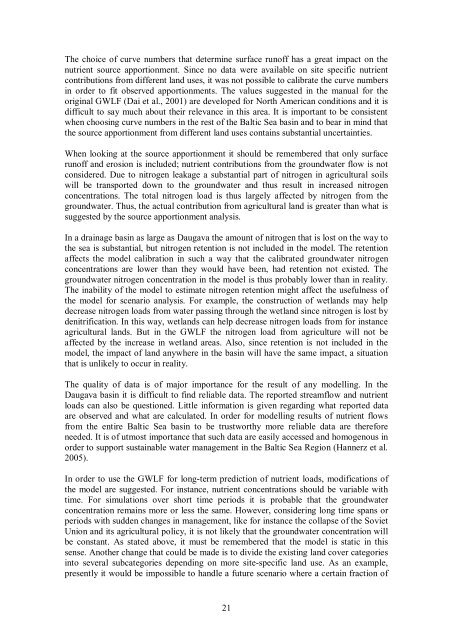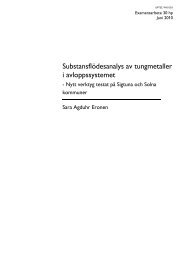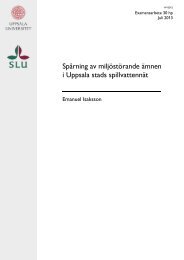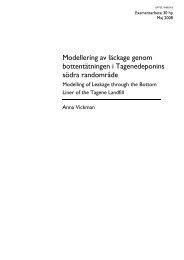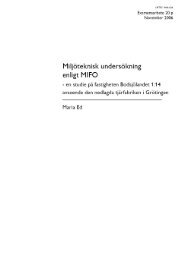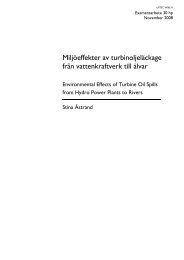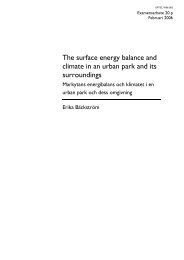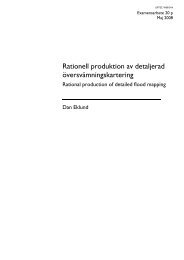Nutrient Transport Modelling in the Daugava River Basin - DiVA Portal
Nutrient Transport Modelling in the Daugava River Basin - DiVA Portal
Nutrient Transport Modelling in the Daugava River Basin - DiVA Portal
You also want an ePaper? Increase the reach of your titles
YUMPU automatically turns print PDFs into web optimized ePapers that Google loves.
The choice of curve numbers that determ<strong>in</strong>e surface runoff has a great impact on <strong>the</strong>nutrient source apportionment. S<strong>in</strong>ce no data were available on site specific nutrientcontributions from different land uses, it was not possible to calibrate <strong>the</strong> curve numbers<strong>in</strong> order to fit observed apportionments. The values suggested <strong>in</strong> <strong>the</strong> manual for <strong>the</strong>orig<strong>in</strong>al GWLF (Dai et al., 2001) are developed for North American conditions and it isdifficult to say much about <strong>the</strong>ir relevance <strong>in</strong> this area. It is important to be consistentwhen choos<strong>in</strong>g curve numbers <strong>in</strong> <strong>the</strong> rest of <strong>the</strong> Baltic Sea bas<strong>in</strong> and to bear <strong>in</strong> m<strong>in</strong>d that<strong>the</strong> source apportionment from different land uses conta<strong>in</strong>s substantial uncerta<strong>in</strong>ties.When look<strong>in</strong>g at <strong>the</strong> source apportionment it should be remembered that only surfacerunoff and erosion is <strong>in</strong>cluded; nutrient contributions from <strong>the</strong> groundwater flow is notconsidered. Due to nitrogen leakage a substantial part of nitrogen <strong>in</strong> agricultural soilswill be transported down to <strong>the</strong> groundwater and thus result <strong>in</strong> <strong>in</strong>creased nitrogenconcentrations. The total nitrogen load is thus largely affected by nitrogen from <strong>the</strong>groundwater. Thus, <strong>the</strong> actual contribution from agricultural land is greater than what issuggested by <strong>the</strong> source apportionment analysis.In a dra<strong>in</strong>age bas<strong>in</strong> as large as <strong>Daugava</strong> <strong>the</strong> amount of nitrogen that is lost on <strong>the</strong> way to<strong>the</strong> sea is substantial, but nitrogen retention is not <strong>in</strong>cluded <strong>in</strong> <strong>the</strong> model. The retentionaffects <strong>the</strong> model calibration <strong>in</strong> such a way that <strong>the</strong> calibrated groundwater nitrogenconcentrations are lower than <strong>the</strong>y would have been, had retention not existed. Thegroundwater nitrogen concentration <strong>in</strong> <strong>the</strong> model is thus probably lower than <strong>in</strong> reality.The <strong>in</strong>ability of <strong>the</strong> model to estimate nitrogen retention might affect <strong>the</strong> usefulness of<strong>the</strong> model for scenario analysis. For example, <strong>the</strong> construction of wetlands may helpdecrease nitrogen loads from water pass<strong>in</strong>g through <strong>the</strong> wetland s<strong>in</strong>ce nitrogen is lost bydenitrification. In this way, wetlands can help decrease nitrogen loads from for <strong>in</strong>stanceagricultural lands. But <strong>in</strong> <strong>the</strong> GWLF <strong>the</strong> nitrogen load from agriculture will not beaffected by <strong>the</strong> <strong>in</strong>crease <strong>in</strong> wetland areas. Also, s<strong>in</strong>ce retention is not <strong>in</strong>cluded <strong>in</strong> <strong>the</strong>model, <strong>the</strong> impact of land anywhere <strong>in</strong> <strong>the</strong> bas<strong>in</strong> will have <strong>the</strong> same impact, a situationthat is unlikely to occur <strong>in</strong> reality.The quality of data is of major importance for <strong>the</strong> result of any modell<strong>in</strong>g. In <strong>the</strong><strong>Daugava</strong> bas<strong>in</strong> it is difficult to f<strong>in</strong>d reliable data. The reported streamflow and nutrientloads can also be questioned. Little <strong>in</strong>formation is given regard<strong>in</strong>g what reported dataare observed and what are calculated. In order for modell<strong>in</strong>g results of nutrient flowsfrom <strong>the</strong> entire Baltic Sea bas<strong>in</strong> to be trustworthy more reliable data are <strong>the</strong>reforeneeded. It is of utmost importance that such data are easily accessed and homogenous <strong>in</strong>order to support susta<strong>in</strong>able water management <strong>in</strong> <strong>the</strong> Baltic Sea Region (Hannerz et al.2005).In order to use <strong>the</strong> GWLF for longterm prediction of nutrient loads, modifications of<strong>the</strong> model are suggested. For <strong>in</strong>stance, nutrient concentrations should be variable withtime. For simulations over short time periods it is probable that <strong>the</strong> groundwaterconcentration rema<strong>in</strong>s more or less <strong>the</strong> same. However, consider<strong>in</strong>g long time spans orperiods with sudden changes <strong>in</strong> management, like for <strong>in</strong>stance <strong>the</strong> collapse of <strong>the</strong> SovietUnion and its agricultural policy, it is not likely that <strong>the</strong> groundwater concentration willbe constant. As stated above, it must be remembered that <strong>the</strong> model is static <strong>in</strong> thissense. Ano<strong>the</strong>r change that could be made is to divide <strong>the</strong> exist<strong>in</strong>g land cover categories<strong>in</strong>to several subcategories depend<strong>in</strong>g on more sitespecific land use. As an example,presently it would be impossible to handle a future scenario where a certa<strong>in</strong> fraction of21


